Double neck guitars have long held a special place in rock history, instantly recognizable and synonymous with guitar gods like Jimmy Page. The image of Page wielding his Gibson EDS-1275 remains iconic, sparking dreams in countless aspiring musicians. While visually stunning, these instruments were often heavy, expensive, and relatively uncommon. Yet, the allure of the double neck persists, projecting an aura of mastery and virtuosity.

Beyond Page, other guitarists such as Rick Nielsen and Don Felder have embraced the double neck, further cementing its legendary status. Slash, famed for his work with Guns ‘n Roses, Velvet Revolver, and his solo projects, also joined the ranks of double neck players. In the late 1990s and early 2000s, Slash collaborated with Guild Guitars to create the Crossroads doubleneck, a unique instrument that is the focus of this review. While Slash is now associated with Gibson, his Guild collaboration remains a fascinating chapter in double neck guitar history.
The Guild Crossroads doubleneck first appeared in the 1997-1998 Guild Gallery magazine, showcased in the custom shop section. Promotional materials from that era highlight its patented design, though the specifics of this patent are somewhat unclear. Despite the mystery surrounding the patent, the guitar itself quickly gained attention.
Interestingly, further investigation reveals US Patent #4,987,815, granted in 1991 to Gary Shockley, which describes a combination electric and acoustic guitar. This patent may be the basis for the “patented Crossroads™ doubleneck” mentioned in Guild catalogs. The original patent illustration is quite something to behold, a testament to Guild and Slash’s refined execution of this concept.
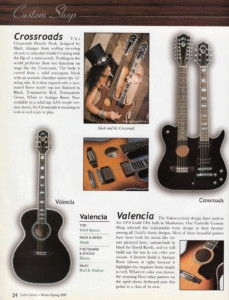
Guild catalogs from 1997 to 2002 consistently featured the Crossroads doubleneck, noting its construction. The 6-string neck and electronics were derived from the Guild Bluesbird, while the 12-string side was described as chambered. This construction diverged from traditional acoustic guitar building methods, likely due to the instrument’s slim profile. Available colors included Black, Transparent Red, Transparent Green, White, and Antique Burst, reflecting the aesthetic preferences of the era.
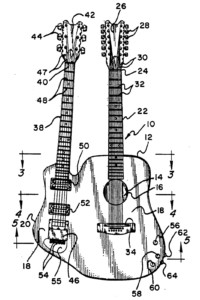
Price lists from 2001 placed the Crossroads doubleneck as the most expensive guitar in Guild’s lineup at the time, excluding the Benedetto series. This high price point underscored its status as a premium, custom shop instrument.

Slash himself was frequently pictured with various iterations of the Crossroads doubleneck, including a striking transparent green model with a 6-string acoustic top and an ebony fretboard on the lower neck. These images and videos of Slash playing the Crossroads, like in performances of “Anastasia” and “Neither Can I”, further fueled the guitar’s desirability.
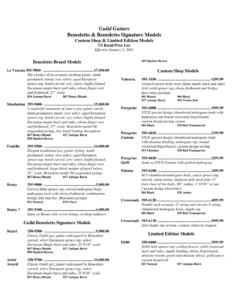
Given the rarity and value of the Guild Crossroads doubleneck, potential buyers should be wary of fakes. Authenticating these guitars can be challenging due to variations and the existence of high-quality replicas. Details like the label inside the soundhole, which can be either printed or hand-written on genuine models, need careful examination. Consulting with Guild experts like Hans Moust, author of “The Guild Guitar Book”, is advisable when verifying authenticity.

The Case: A Giant in Green
The Guild Crossroads doubleneck comes with a custom case as substantial as the guitar itself. Its size is dictated by the instrument’s dimensions, resulting in a large, somewhat thin case. This thinness can make it a bit unstable when standing upright, so caution is advised to prevent tipping.
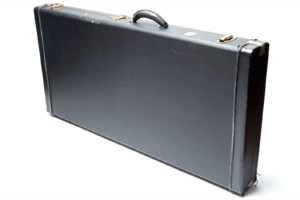
Despite its unwieldy size, the case is well-constructed with a robust handle, essential for carrying the guitar’s significant weight. Opening the case reveals the signature green lining found in Guild Custom Shop guitars of this era. A common issue observed in these cases is fading of the green lining, possibly a manufacturing defect.

A genuine case for the Crossroads doubleneck will feature a Guild Custom Shop badge. Purchasing this guitar without its original case is not recommended, as it raises concerns about authenticity and proper protection. Due to its unique shape and size, finding aftermarket cases would be difficult.
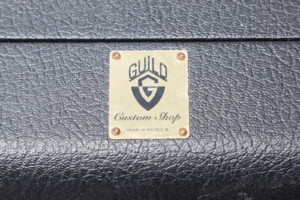
The sheer size of the case presents storage challenges. It’s significantly larger than standard guitar cases, making it cumbersome to store and transport. As a point of reference, comparing it to a Guild Nightbird case highlights its considerable bulk. While the case’s size is inconvenient, it is a necessary component for protecting this unique instrument.
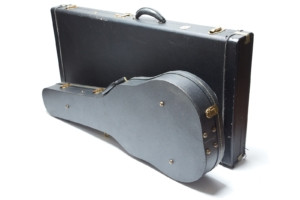
Nitrocellulose Lacquer Finish: A Deep Red Hue
Guild’s 2002 catalog, part of the Fender Frontline series, specifies a Nitrocellulose Lacquer finish for the Crossroads doubleneck. UV light testing confirms this, revealing the characteristic fluorescence of aged nitro finishes. The finish on this particular guitar is a very dark red, closely represented in photos.

Fretboards and Necks: Contrasting Designs
The Guild Crossroads doubleneck, despite being a single instrument, is essentially two guitars joined together. Both necks share a 24 ¾” scale length, but differ significantly in design and appointments. The 6-string electric side features a bound rosewood fretboard with V-block inlays, typically associated with higher-end Guild models. Conversely, the 12-string acoustic side has an unbound rosewood fretboard with simple dot inlays, more common on entry-level Guild guitars. This contrast is unusual, perhaps a specific design choice by Slash, or a cost-saving measure.
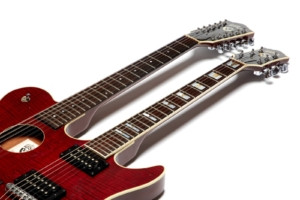
Changing strings on a doubleneck guitar is a more involved process than on a standard guitar. With 18 strings in total, including 12 mini-tuners on the 12-string side, restringing becomes a significant task. The close proximity of the necks also makes using a string winder on the inner tuners impossible, requiring manual tuning for these strings. This design element presents a practical challenge for regular maintenance and quick string changes.

Another unique aspect is the differing neck angles. Initially, this might appear as a flaw, but careful measurement reveals that both necks are correctly aligned with their respective bridges. This intentional difference in angle likely accommodates the varying bridge heights of the 6-string and 12-string sides.

Both necks are substantial in size. The 6-string neck measures 1 ¾” at the nut, while the 12-string neck is slightly wider at 1 13/16″. The 6-string neck is solid mahogany, similar to a Guild Bluesbird, while the 12-string neck is constructed from a 3-piece mahogany/maple/mahogany configuration, reminiscent of vintage Guild 12-strings like the D212 or F212. Both fretboards have a 12″ radius and utilize .05″ x .105″ frets.

Build Quality: Laminate Top and Chambered Body
Catalogs indicate the top is a laminate, which is confirmed upon inspection. The maple top is approximately .15″ thick on the 12-string side and appears similarly thin on the 6-string side. This laminate construction differs from carved maple tops found on Les Pauls or higher-end Guild Bluesbirds. While not as tonally resonant as a thick carved top, the laminate helps manage the guitar’s overall weight.
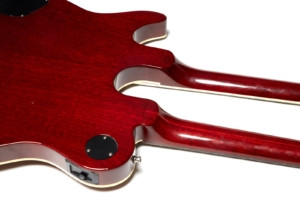
The guitar weighs a hefty 11lbs 11oz (5.3 kg), approaching 12 pounds. While heavy, the weight distribution across the larger body makes it feel somewhat manageable, though extended performances with a standard strap might be tiring.
The back and sides of the 12-string acoustic side are not built like a traditional acoustic guitar. Instead, they resemble a chambered electric guitar construction, using hollowed mahogany rather than pressed or laminated wood typical of acoustic instruments. Both necks are joined using traditional Guild set-neck construction. The body features a 5-layer binding on the front, adding to its aesthetic appeal.
Delivery Issues: Imperfections Upon Arrival
Upon receiving this particular Guild Crossroads doubleneck, some minor issues were discovered. A crack was present in the top, running along the seam of the book-matched veneer. This crack is likely due to stress from the 12-string bridge, possibly exacerbated by prolonged storage with strings at full tension.
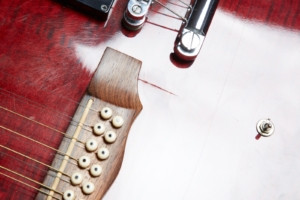
Additionally, the 6-string neck showed signs of fretboard separation that had been repaired, albeit noticeably. The repair was identified by excess glue near the first fret. Despite these issues, neither problem significantly affects the playability of either neck. However, given the guitar’s value, these imperfections were grounds for seeking partial compensation from the seller, which was successfully obtained through Reverb’s intervention.

These issues are not indicative of inherent build quality flaws but rather delivery and pre-existing damage. However, thorough disclosure of any imperfections is expected when purchasing high-value instruments.

Pickups: Seymour Duncan and Fishman
As a dual instrument, the Guild Crossroads features separate pickup systems for the 6-string electric and 12-string acoustic sides.
6-String Pickups
The 6-string side is equipped with Seymour Duncan Alnico II Pro humbuckers, specifically the APH1B (bridge) and APH1NL (neck) models. These are the same pickups Slash used in his original “Appetite for Destruction” guitar, renowned for their PAF-like character and Alnico II growl. These pickups are low-wind and deliver a classic, vintage tone. Unlike some modern Seymour Duncan pickups, these lack prominent branding, maintaining a cleaner aesthetic. Their excellent tone quality makes pickup replacement unnecessary.

12-String Pickup
The 12-string side utilizes a Fishman transducer-equipped bridge. This piezo pickup system is discreet, with only a volume control on the upper bout and the saddle-mounted transducer being visible. The electronics for this system are located internally.
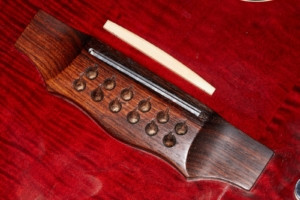
Electronics: Complex and Integrated
The controls are designed to be relatively intuitive. Standard G-shield knobs control the 6-string electric side, with a pickup selector switch located on the upper bout of the 12-string side. A single volume slider on the 12-string’s upper bout controls the acoustic pickup. A mini-toggle switch near the bottom strap peg selects between the electric and acoustic outputs.
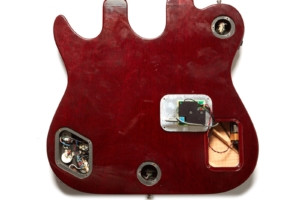
Tracing the wiring reveals a Fishman AGP2 Rev2 preamp for the acoustic side. This preamp features hidden stacked potentiometers for treble and bass roll-off, accessible only by removing a cover. The volume slider replaces one of the standard preamp knobs, while the tone controls are intentionally concealed, perhaps a design choice influenced by Slash.
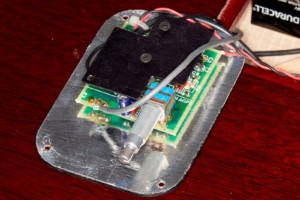
The placement of the 6-string pickup selector on the 12-string side is an unusual design choice, likely dictated by space constraints and potentially inspired by Les Paul layouts. The wiring is complex, with both guitars converging at a 5-position terminal strip in the 6-string control cavity. Cable sheaths are uniformly black, and wire colors are reused across different circuits, making tracing the wiring challenging.

Despite the complexity, the wiring scheme is logically organized, with consistent color-coding for signal paths and ground. The guitar selector mini-toggle effectively switches the output between the acoustic and electric circuits. All potentiometers are 500k, and capacitors are .022 μF. Due to the intricate electronics, DIY modifications are not recommended for those unfamiliar with guitar wiring.
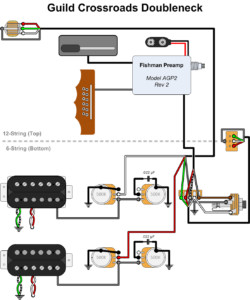

Hardware: Grover Tuners and Gotoh Bridge
The sheer number of tuners is immediately noticeable, with 18 Grover Rotomatic machine heads in total – six full-size and 12 mini-tuners. These tuners are high quality and functional but contribute significantly to the guitar’s headstock weight, totaling approximately 1.51 lbs (.69 kg).
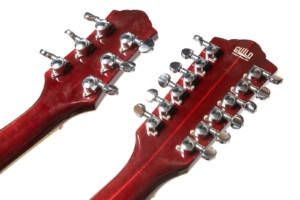
Knobs are black G-shield knobs typical of late Westerly-era Guilds, although variations with different knobs have been observed. Strap pegs are Fender strap locks, likely not original but a practical addition for gigging. Given the guitar’s weight, strap locks and a wide strap are highly recommended.
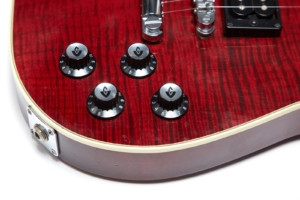
The 12-string side features a rosewood bridge with classic Guild curves and plastic string pegs with black dots. The 6-string side uses a Gotoh bridge and tailpiece, standard hardware for Guild electric guitars of this period. There is no pickguard, showcasing the flamed maple top, but resulting in some surface scuffs. The pickup selector switch is a standard 3-way toggle, while the guitar selector is a mini-toggle.

Sound: Versatile Tones, Compromised Acoustics
Recording the Guild Crossroads doubleneck presents unique opportunities due to its combination of electric and acoustic capabilities. While the 12-string side is acoustic with a piezo pickup, it doesn’t replicate the full-bodied sound of a traditional jumbo acoustic guitar due to its thinner body.
Sound Samples (6-string – ODS100 Clean & JCM-800 Patches):
(Audio samples as per original article – descriptions maintained)
The 6-string side, while not possessing the full sustain and ring of a dedicated Bluesbird or Nightbird, is still capable. The Seymour Duncan Alnico II Pro pickups deliver expected tones from a mahogany solid-body with these pickups. A notable characteristic is the sympathetic resonance from the 12-string side, adding a unique liveliness to the 6-string sound.

Sound Samples (12-string – ODS100 Clean Patch):
(Audio samples as per original article – descriptions maintained)
The 12-string acoustic side, unplugged, can sound somewhat ukulele-like due to its thin body. Using a capo presents challenges common to 12-string guitars, requiring careful tuning adjustments. While the acoustic tone is usable, it is a compromise compared to a dedicated 12-string acoustic guitar. Better acoustic tones could likely be achieved with dedicated acoustic amplification and effects.
Playability: Neck Dive and Ergonomic Challenges
Standing with a strap reveals significant neck dive due to the heavy headstock and strap peg placement. This neck-heavy balance makes playing while standing somewhat challenging, requiring constant effort to keep the necks from falling. Moving the top strap peg higher on the neck heel could potentially alleviate this issue, but is not a practical modification.

Adjusting strap height for optimal comfort is also complex. Finding a balance that suits both necks is difficult, often requiring a compromise where neither neck is perfectly positioned. Intonation on the 12-string side is not ideal, especially when using a capo.
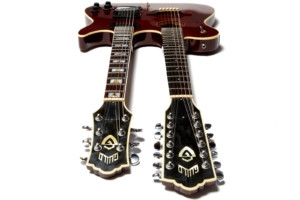
Sitting, playability improves significantly for both necks. However, the large body can cause discomfort and bruising on the arm and chest due to its high profile.
Conclusion: A Niche Instrument for a Specific Need

The Guild Crossroads doubleneck is a specialized instrument best suited for players with a specific need for its unique combination of electric 6-string and acoustic 12-string capabilities. If you require both electric and acoustic tones in a single guitar, and desire a more acoustic-leaning 12-string sound than a typical electric double neck, the Crossroads is a compelling, albeit rare, option. It stands out as one of the few guitars that effectively integrates these features.
However, for players simply curious about double neck guitars, or seeking a more general-purpose instrument, the Guild Crossroads doubleneck is likely not the ideal choice. Its rarity, high price, weight, and balance issues make it less practical for casual use. Exploring more accessible double neck options, such as Epiphone models, is recommended for those new to double neck guitars. Even considering the current Gibson Slash ’66 reissue doubleneck, while expensive, doesn’t offer the acoustic 12-string element of the Guild.
Despite its drawbacks, the Guild Crossroads doubleneck remains a desirable instrument, particularly for collectors of rare Guild guitars or those with a genuine need for its unique functionality. Its stage presence is undeniable, projecting an iconic rockstar image. For those who fit this niche, the Guild Crossroads doubleneck offers a unique and impressive playing experience.
